Wednesday, June 9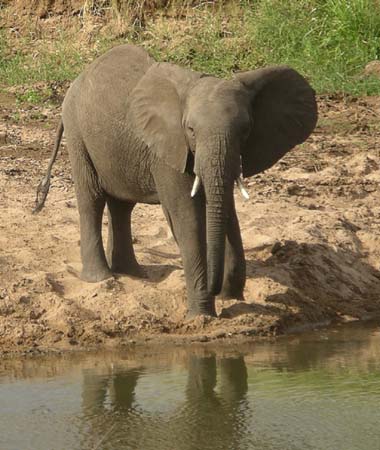
Steve: Our sleep last night was subject to the frequently
loud serenading by a variety of animals, particularly a nearby pack of hyenas.
At one point, Paula woke me up and in a frightened voice asked me whether
I was snoring. I hope that I don't snore as loudly as the sounds we heard
last night… The Tarangire Safari Lodge is situated within the boundaries
of the wildlife park, and is surrounded by a large number of animals. There
are notes warning guests not to leave their tents at night, and the lodge
provides escorts who make sure that people make it safely back after dinner
in the dining area. We're not sure what the escorts do if they encounter a
lion or leopard, but they at least make us feel safer.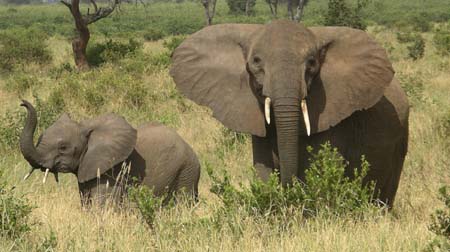
This was our last full day of wildlife viewing in Tanzania. We set out early
this morning to further explore the Tarangire National Park, heading south
toward the area where we saw animals coming from yesterday afternoon. Nassibu
thought that perhaps there were predators in the southern part of the park,
driving the zebra and impala toward the north. As always seems to be the case,
every time we head out with Nassibu to see the wildlife we find ourselves
experiencing new and interesting things. Today was no exception.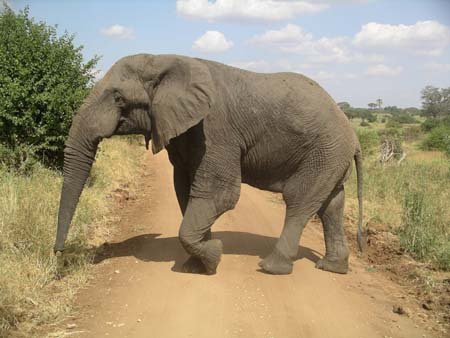
Tarangire is famous for its elephants, and today we counted 176 plus probably another 100 or so that were spread throughout a huge swamp in the distance. Nassibu is wonderful at recognizing where a particular family of elephants is heading, positioning our Land Rover so that we can observe without scaring them off, and then at the exact right moment moving to a spot so that they cross the road directly in front of us. We had several such encounters today, and it's really wonderful to observe these huge animals at close range.
One particularly memorable scene occurred by the Tarangire River where we
started by watching a young bull drinking. As he finished, he was approached
by another juvenile male. They first greeted each other by placing their trunks
in each other's mouths, and then engaged in a playful elephant wrestling match.
The elephants repeatedly charged each other, locking trunks and butting heads.
We could hear their tusks hitting each other, and laughed as the elephants
playfully carried on along the river. This went on for at least 30 minutes,
and they were still at it when we finally left.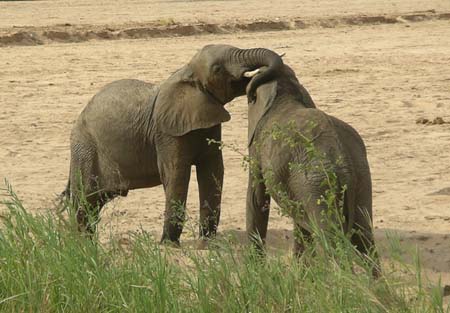
While this was happening, a pair of mothers and their three young ones (including
two babies) were watching and clearly preparing for their turn to walk down
the riverbank for a drink. The mothers are extremely cautious, and in particular
wanted to make sure that our presence wasn't a danger to their young. Eventually,
the small family scrambled down a small hill and 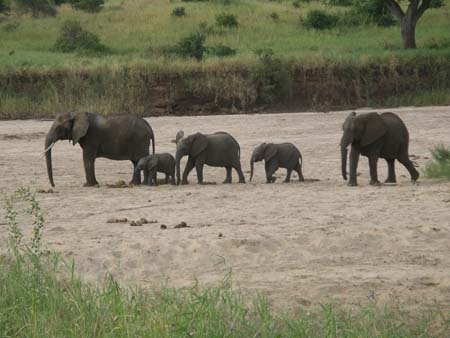 drank
from the river. The smallest baby (only a few months old) stayed right by
her mother, and appeared to be nursing. This was the closest we have come
to such a small elephant, and we loved seeing how the family all protects
the little ones.
drank
from the river. The smallest baby (only a few months old) stayed right by
her mother, and appeared to be nursing. This was the closest we have come
to such a small elephant, and we loved seeing how the family all protects
the little ones.
Today provided us with the opportunity to observe some very interesting elephant
behaviors. We watched as several of the elephants raised their trunks in the
air - this is their 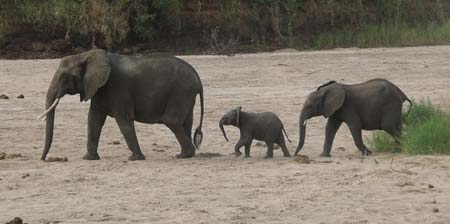 way
of carefully smelling something that has caught their attention. We heard
several young elephants with their distinctive trumpeting, indicating that
something has scared them. We were close enough to several families to be
able to hear the mothers make a stomach-grumbling sound which is their way
of communicating to the young ones, often asking them to follow. And of course,
we already knew that the elephants flap their ears as a cooling mechanism.
We found it fascinating to see all these behaviors in the wild.
way
of carefully smelling something that has caught their attention. We heard
several young elephants with their distinctive trumpeting, indicating that
something has scared them. We were close enough to several families to be
able to hear the mothers make a stomach-grumbling sound which is their way
of communicating to the young ones, often asking them to follow. And of course,
we already knew that the elephants flap their ears as a cooling mechanism.
We found it fascinating to see all these behaviors in the wild.
Our most exciting sighting today was a small leopard that we initially found
right in the road. Leopards are one of the hardest animals to find, because
they generally sleep during the day and hunt at night. There are actually
more leopards in Tanzania than lions, but since they spend their days sleeping
in caves or trees they are rarely seen. When they are spotted, it's 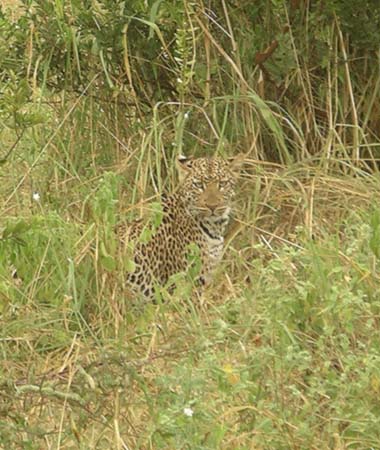 usually
at a distance on the branch of a tree, as was the case with the leopard we
saw yesterday and the one we saw on our first day in the Serengeti.
usually
at a distance on the branch of a tree, as was the case with the leopard we
saw yesterday and the one we saw on our first day in the Serengeti.
We were all startled by seeing this beautiful cat right in the road, and
Nassibu quickly stopped the Land Rover. The leopard then moved off the road
into a small patch of grass in front of us. For probably 10 minutes, we stared
at him and he stared right back. His face was absolutely beautiful! Finally,
he started walking toward us through the grass, and then turned toward a small
clearing. We watched as the leopard crouched down and then made a huge leap
toward a spur fowl, a bird that's one of its favorite snacks. The leopard
flung its paw into the air as the bird 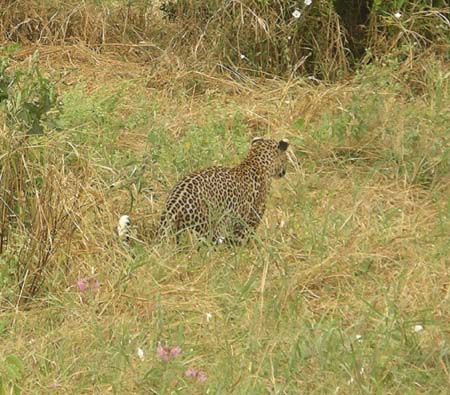 flew
off, barely making its escape. We couldn't believe how high the leopard jumped,
and can now better appreciate why it's recognized as the most effective predator
of all.
flew
off, barely making its escape. We couldn't believe how high the leopard jumped,
and can now better appreciate why it's recognized as the most effective predator
of all.
We know that we were very lucky to see leopards - Nassibu told us that many
people come to Tanzania and never see one at all. To have viewed one that
was at such close range and actually awake and moving around was even more
special. This was yet another memory from our time here in Tanzania that will
stay with us for a long time.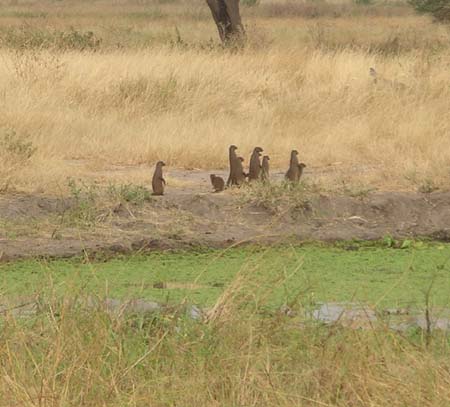
Since the beginning of our safari, David and Katie have been waiting to see
mongoose standing "on their hinds" (as they jokingly call it). Nassibu
is always careful not to make promises, but he had in fact promised that we
would see some mongoose here in the Tarangire. The mongooses actually live
in termite mounds, and they eat the resident termites before making the mounds
their homes. Not that 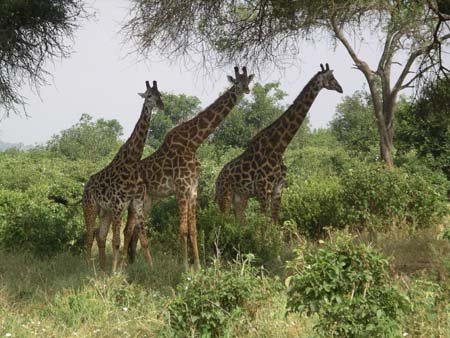 Nassibu
was worried, but we're sure he must have been at least a little relieved today
when we found a spot where we could see both banded and dwarf mongooses playing
and even standing "on their hinds". We all had a great time watching
these cute little creatures, and Katie and David in particular had fun in
finally seeing the mongooses that they had been so longing to see! Nassibu
told us tonight that from now on, every time he sees a mongoose he'll
Nassibu
was worried, but we're sure he must have been at least a little relieved today
when we found a spot where we could see both banded and dwarf mongooses playing
and even standing "on their hinds". We all had a great time watching
these cute little creatures, and Katie and David in particular had fun in
finally seeing the mongooses that they had been so longing to see! Nassibu
told us tonight that from now on, every time he sees a mongoose he'll 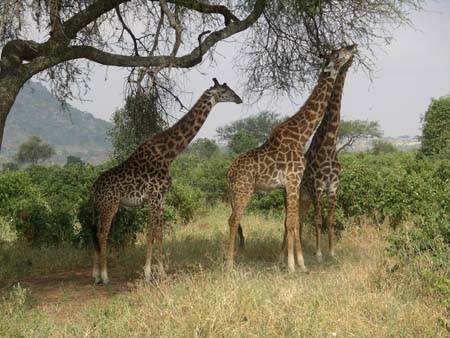 think
of David and Katie…
think
of David and Katie…
We haven't mentioned much about birds in our journals, but Tarangire is also
very famous for its huge variety of birdlife. In particular, there are a huge
number of birds of prey, and we 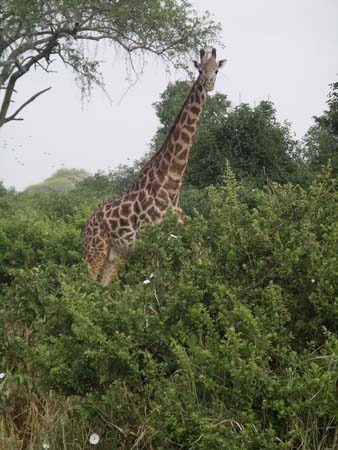 often
see them perched high on the tops of trees. Today's sightings included a long
crested eagle, and several brown snake eagles. It's really amazing to see
so many large birds all in one place.
often
see them perched high on the tops of trees. Today's sightings included a long
crested eagle, and several brown snake eagles. It's really amazing to see
so many large birds all in one place.
Tomorrow will be our last opportunity for game viewing in Tanzania. We'll spend the morning looking at Tarangire's wildlife, and then will drive back to Arusha in the afternoon. It's hard to believe that our time in Tanzania is almost at its end. This has been an incredible experience for us all.
Animals seen today:
Zebra
Banded Mongoose
Dwarf Mongoose
Slender Mongoose
Jackal
Leopard
Giraffe
Ostrich
Elephant (176+)
Leopard Turtle
Vervet Monkey
Dik-Dik
New birds seen today:
Brown Snake Eagle
Long Crested Eagle
Crowned Horn Bill
Lovebird
Stork
African Fish Eagle
